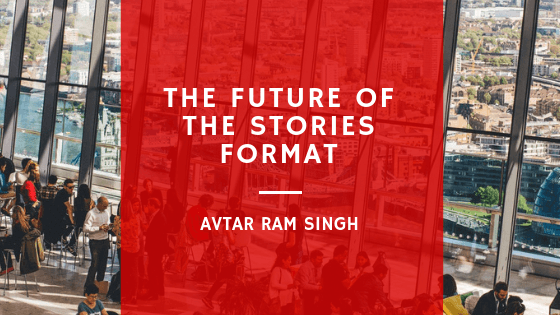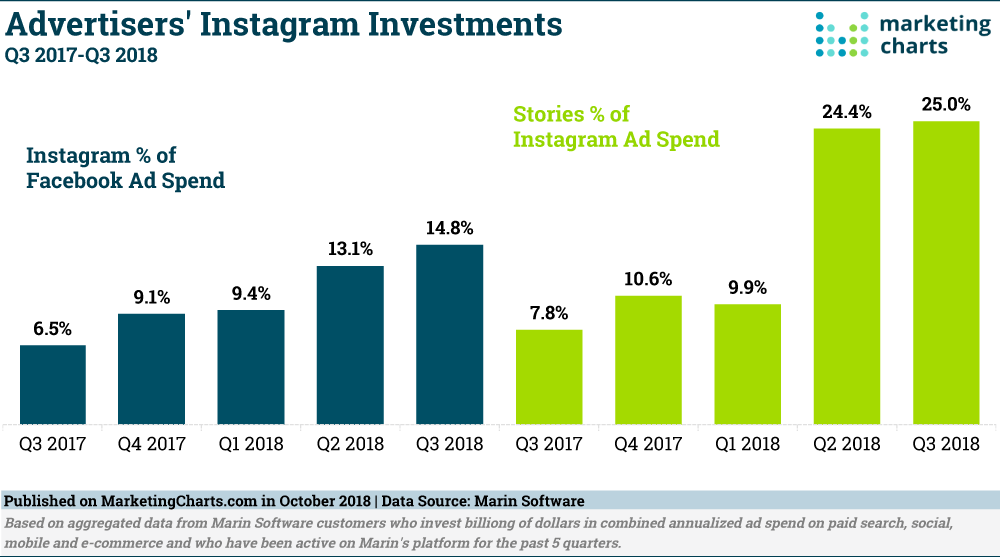
By Avtar Ram Singh, {grow} Contributing Columnist
The Stories format has become increasingly important for Facebook, now accounting for double-digit revenue growth. But it has to grow and evolve and today I’ll tell you what to expect.
The Stories Focus
Four times a year Facebook announces their quarterly results over an investor call, which gets chopped up and analyzed by hundreds of people around the world. After all, when the CEO of a $400B+ company with 2B+ users talks about its financial results, the state of the market and where it’s headed, people are bound to sit up and take notice.
The Q3 results call was no different. Most interesting in the call though, was Zuckerberg’s focus on the Stories format.
Recode reported:
Stories, the ephemeral photo and video posts that Facebook copied from Snapchat, was mentioned continuously throughout the hour-long call — a total of 71 times, according to the call transcript.
Stories has been a huge hit inside of Facebook’s apps, especially Instagram and WhatsApp. Zuckerberg even said that people will share more to Stories than they will to Facebook or Instagram’s feeds in the “not-too-distant future,” making Stories one of the most dominant ways that people share photos and videos online.
“I just think that this is the future,” Zuckerberg said. “People want to share in ways that don’t stick around permanently, and I want to be sure that we fully embrace this.”
The Stories Format Advantage
I’ve always said that one of the key differentiators for Facebook is its ability to create uniquely customizable advertising formats, such as the Carousel, the Canvas, Collection ads and Lead Generation forms. Facebook has never shied away from producing “content products” that advertisers can use to creatively reach out to their customers on the platform and drive specific actions.
It’s no surprise then, that when Snapchat started making some noise in 2012, Facebook sat up and took notice of a format they hadn’t thought of yet. I’d even go so far as to say that Snapchat stumbled into the Story format. They were looking at creating an ephemeral photo-sharing app, and it only made sense to let people view a picture across the entirety of your screen, with text and scribbles over it.
Snapchat used the word “Story” only when users added them as part of their “24 hour profile” section.
Regardless, Facebook saw something they liked, in fact they liked it enough to offer $3B for it, which would famously be turned down by Snapchat CEO Evan Spiegel.
It was a new way to communicate, it was inherently social, and as an astute business leader, Zuckerberg saw the value and the potential. Undeterred by Snapchat turning his bid down, he turned Instagram full force into a Snapchat killing machine, and few would argue against the point that Zuckerberg has succeeded.

In case you needed convincing, this chart from Statista should settle it. Instagram Stories has more than 2x the number of users of Snapchat, and blew past the company months after launch in terms of user metrics. Snapchat for the last few quarters has not reported positive figures.
Advertiser Adoption
Surpassing Snapchat in number of users is one thing, but the entire point of making that crazy market grab needs to lead to revenue. And that comes from… you guessed it, advertisers.
While users have adopted the Stories format with little resistance, Facebook has a problem. And that problem, is… you guessed it, advertisers.
The very astute Kurt Wagner continued in the aforementioned Recode story:
There is a problem with Facebook’s obsession with Stories, though: The business isn’t there yet, which means that as users turn their time and attention to Stories, and away from the feed, Facebook is scrambling to build a business that can capitalize on that shift in attention.
Snapchat had a simpler time with the format, it only had one to offer. Snapchat built a business on a single format, adding in Discover for long-form videos in Story format, adapting Stories into quizzes, questionnaires and so on. For Facebook, their biggest innovation was the newsfeed and the content formats associated with it, so how then should the company juggle Stories which are engineered to break people away from the feed?
WhatsApp Ads
The Stories format exists across all four of Facebook’s properties – WhatsApp, Messenger, Instagram and Facebook itself.
A story by NDTV in the end of October 2018 noted that advertising was coming to WhatsApp as well.
Clearing the air on Facebook’s monetization efforts towards WhatsApp, the mobile messaging service’s Vice President Chris Daniels on Wednesday said the company is going to put advertisements in its “Status” feature.
“We are going to be putting ads in ‘Status’. That is going to be primary monetization mode for the company as well as an opportunity for businesses to reach people on WhatsApp,” Daniels told reporters in New Delhi on Wednesday.
So that’s every single Facebook property to be monetized by advertising, with a lot hinging on the Stories format.
The Missing Core Facebook DNA
For advertisers, Facebook is special due to its content formats. When Instagram became part of the Facebook family and advertising on Instagram rolled out via the Facebook ads manager, it was only a matter of term before Facebook introduced the Carousel format on Instagram.
Link ads followed, with app-install ads on their tail. Today, for a sizable enough amount advertisers can run surveys on Instagram to measure brand recall and lift. Instagram had been turned into an advertising machine by Facebook, generating incredible revenue for the organization to the point where Bloomberg reported Instagram should be worth $100B.
The same story noted:
Instagram could account for about 16 percent of Facebook’s revenue over the next year, up from 10.6 percent last year, according to eMarketer data cited by Bloomberg Intelligence. The unit announced the addition of Instagram television, or IGTV, last week as an attempt to catalyze future growth. Most of Instagram’s 2018 revenue growth will still likely come from its newsfeed ads, as the TV platform is still developing.
Those numbers are corroborated by Marin Software, that released some interesting figures around the advertising expenditure of their clients.

Thanks to this data from Marin Software and Marketing Charts, things begin to get really interesting. Bloomberg Intelligence’s data wasn’t that far off when they said Instagram could generate 16% of Facebook’s revenue in 2019, as figures in 2019 are slowly approaching that figure and will likely surpass it.
If 15% of Facebook advertising spend goes to Instagram, and 25% of that goes to the Stories format, that’s 4% of total Facebook advertising revenue coming from a single content format from a single platform. And that number is only rising, so there’s no wonder that Zuckerberg is talking about Stories and private sharing being the future of the network.
Which brings me to the crucial point in this article. In order for Facebook to see increasing returns from the Stories format, they need to do what they’ve always done with advertising products. Get creative with the content formats.
Stories: The Dominant Format of the Future
Before we talk about the path forward to Stories, it’s important to look at where they’ve come from, and how they’ve evolved.
Ian Bogost in a story (pun-intended) in the Atlantic noted:
But a Story, of the Instagram and Snapchat sort, is something much more specific. It’s a collection of images and short videos, with optional overlays and effects, that a user can add to over time, but which disappears after 24 hours. Users view a Story in sequence, either waiting out a programmed delay between images or manually advancing to the next.
That’s about the most bizarrely precise definition of “story” I’ve ever heard. But even if Stories aren’t really stories, they deserve careful attention, especially given Cox’s warning. Like them or hate them, Stories might be the first true smartphone media format. And that might mean that they will become the dominant format of the future.
The dominant format of the future. Based on the last Facebook earnings call, I’d say Zuckerberg is in agreement with Bogost.
Bogost continues:
Stories is not a technology, nor is it a feature. It is a media format, or even a genre, in the way that a magazine or a murder mystery or a 30-minute television program is. This is also why it’s a little silly to worry about who “copied” Stories from whom, since the whole point of formats and genres is to develop independent of single tools of creation and dissemination. The different styles of Story illustrate the form’s broad uses. On Snapchat, Stories are more informal, making use of the face-filters and geotags common to that platform. On Instagram, filters and Boomerangs and neon text and the like are more frequently used, as that platform’s heavily composed manner warrants.
And there it is.
If Stories is the dominant format of the future, and Facebook is looking to cash-in on that format as they’ve done exquisitely with social video, the path forward feels obvious.
Converting Stories from Passive Engagement to Active Interactions
Marketers have an obsession with measuring everything. We may not know what to do with all that measurement data, but dammit we’re going to capture and hoard as much of that data as possible. Marketers have also recently begun shifting away from vanity metrics such as impressions, views and reach in the quest for something that feels more action-oriented.
Facebook’s primary clients are advertisers. And while Stories adoption by advertisers might be on an upswing, there are seldom case studies or discussions around the effectiveness of the Stories format. Because as things stand, Stories across all of Facebook’s properties can give you only one action, a swipe-up which is the equivalent of a visit to your website. Not enough.
As such, I’d bet that Facebook over the next 12 months is going to get aggressive with variations of the Stories format for advertisers, along the lines of:
- The elementary stuff like letting people take part in a poll, or engage with the “slider” format – all in an effort to gather feedback.
- Use the “Ask a Question” feature to run AMAs, or pivot it as a feedback tool
- Incorporate lead generation forms, something that many brands love doing in the Facebook newsfeed. It’s effective.
- Quizzes, contests and other “engagement” heavy formats to prove the effectiveness of the medium, and the willingness of people to engage.
Expecting Stories to incorporate e-commerce heavily (in a native manner) might be too big an ask for the next 6-9 months, but I’d wager that after proving the effectiveness of Stories as an engagement format, generating a few case studies on how brands have used it might then be used as a springboard to test e-commerce.
All of this might indeed have happened at the most opportune time for Facebook. As social media growth in the United States has stalled, Facebook’s going to stop obsessing over growing its user base in North America, and focus on how to retain those existing users and generate maximum revenue from advertisers on those users. Focusing on the Stories product could be the key to that tricky question.
It all seems to have come together quite nicely for Facebook, the only question is how quickly they’ll rise to the challenge.
 Avtar Ram Singh is the Head of Strategy at FALCON Agency, a performance-led, business results oriented marketing agency that operates in South East Asia. He’s built marketing strategies and performance frameworks for brands on global and regional levels, across a variety of industries. You can find him on LinkedIn, and Twitter.
Avtar Ram Singh is the Head of Strategy at FALCON Agency, a performance-led, business results oriented marketing agency that operates in South East Asia. He’s built marketing strategies and performance frameworks for brands on global and regional levels, across a variety of industries. You can find him on LinkedIn, and Twitter.


